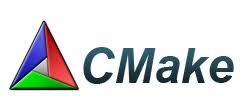CMake¶

As if C and C++ weren’t complicated enough, building programs written in those languages seems to be even more complicated.
(GNU-)Make, a low-level build tool to manage some of the intricacies of the build, has been invented rather early in history. Today it is considered the “assembly language of a build”.
A number of higher level tools have been designed, to manage most of
the rest of the build intricacies, together with some that make
has created on its own. One of these tools, CMake, is introduced in this course.
Target Audience¶
Software developers, mostly. Every developer of a team is concerned about the structure of the project that is maintained by the team. The project’s modules and their interdependencies have to be understood. CMake, if used judiciously, can be used to clearly define project structure.
Agenda¶
Toolchain Introduction¶
What are the problems that CMake solves?
Compiler
Linker
Search paths: header files, libraries
Dependencies
How are these solved by CMake? Present a trivial one-level-only CMake project where compilation and linking happens.
Project Structure, Dependencies¶
As projects become larger, structure is in order. Present a typical project structure where there are separate directories for
Libraries/Modules
Executables
Data files
External Dependencies¶
CMake has so-called “Find Modules” to incorporate code that is not owned by the project, but only used by it.
Quickly introduce what that is
Provide a number of examples
See how a project can react if one such external dependency is not found (optional code)
Code Generators¶
Traditionally, lexers and parser generators (just as a typical example) generate code that has to be built by the project.
Show what problems arise when such generators are use naively
Show how generators are integrated in a CMake project
Automatic Testing¶
Today’s software standards dictate that a project use unit testing (see for example Unit Testing With googletest). See how that can be integrated with CMake.
Installation And Deployment¶
Installation is referred to as locally building code inside the build directory, and that transferring the artifact (executables and libraries, usually) into a well-known location where they are found by others.
Deployment usually means packaging a project, and making it available for installation on other machines - often together with cross compiliation
Recommended Prior Knowledge¶
C or C++ is recommended, obviously. It is good to understand what C’s
#includedirective does (see Functions and Program Structure for#includeand more).A rudimentary understanding of the Unix shell is also helpful (see Linux Basics: Eine Einführung Anhand von Beispielen for Shell topics, and more)
